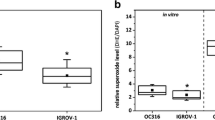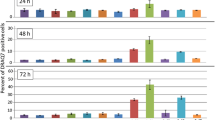Summary
The glucose analogue 2-fluoro-2-deoxy-d-glucose (FDG) was used to study chemosensitivity of two human ovarian cancer cell lines and of murine L1210 cells. Cell viability was determined by measuring intracellular adenosine triphosphate (ATP) with a bioluminescence method, which has been shown to correlate closely with trypan blue, stem cell, and [3H]TdR assays. All three cell lines were sensitive to cytostatic drugs, which exerted a parallel decrease in the intracellular FDG and ATP levels. The two measures correlated positively (r=0.66,P<0.001), indicating that FDG uptake is closely linked with ATP production. Relatively low hexokinase (HK)-to-glucose 6-phosphatase (HK/G6-Pase) ratios were measured, which suggests that the metabolic trapping of FDG 6-phosphate within the cytosol is incomplete. Apparently, these cell lines may not depend exclusively on glycolysis for their energy requirement. We conclude that cell killing caused by cytostatic drugs is associated with a decreased ATP content and FDG uptake. This indicates that not only ATP but also FDG may be used to study drug effects in vitro.
Similar content being viewed by others
References
Abe Y, Matsuzawa T, Fujiwara T, Fukuda H, Itoh M, Yamada K, Yamaguchi K, Sato T, Ido T (1986) Assessment of radiotherapeutic effects on experimental tumors using18F-2-fluoro-2-deoxy-d-glucose. Eur J Nucl Med 12:325–328
Baginski ES, Foà PP, Zak B (1974) Glucose-6-phosphatase. In: Bergmayer HU (ed) Methods of enzymatic analysis. Verlag Chemie, New York London, pp 876–880
Bradner WT (1978) New prescreens for antitumor antibiotics. Antibiot Chemother 23:4–11
Burk D, Woods M, Hunter J (1967) On the significance of glucolysis for cancer growth, with special reference to Morris rat hepatomas. J Natl Cancer Inst 38:839–863
Delicado E, Torres M, Miras-Portugal MT (1986) Effects of insulin on glucose transporters and metabolic patterns in Harding-Passey melanoma cells. Cancer Res 46:3762–3767
DiChiro G, Oldfield E, Wright DC, De Michele D, Katz DA, Patronas NJ, Doppman JL, Larson SM, Ho M, Kufta CV (1989) Cerebral necrosis after radiotherapy and/or intraarterial chemotherapy for brain tumors: PET and neuropathologic studies. AJR 150:189–197
Engelholm SA, Spang-Thomsen M, Vindelov LL (1983) A short-term in vitro test for tumour sensitivity to adriamycin based on flow cytometric DNA analysis. Br J Cancer 47:497–502
Friedman HS, Schold SC Jr, Djang WT, Kurtzberg J, Longee DC, Halperin EC, Falletta JM, Coleman RE, Oakes WJ (1989) Criteria for termination of phase II chemotherapy for patients with progressive or recurrent brain tumor. Neurology 39:62–66
Gallagher BM, Fowler JS, Gutterson NI, McGregor RR, Wan CN, Wolf AP (1979) Metabolic trapping as a principle of radiopharmaceutical design: some factors responsible for the biodistribution of (18F) 2-deoxyglucose. J Nucl Med 19:1154–1161
Heinonen JK, Lahti RJ (1981) A new and convenient colorimetric determination of inorganic orthophosphate and its application to the assay of inorganic pyrophosphatase. Anal Biochem 113:313–317
Kallio S, Kangas L, Blanco G, Johansson R, Karjalainen A, Perilä M, Piippo I, Sundquist H, Södervall M, Toivola R (1986) A new triphenylethylene compound. Fc-1157a: I. Hormonal effects. Cancer Chemother Pharmacol 17:103–108
Kangas L, Grönroos M, Nieminen A-L (1984) Bioluminescence of cellular ATP: a new method for evaluating cytotoxic agents in vitro. Med Biol 62:338–343
Kangas L, Nieminen A-L, Blanco G, Grönroos M, Kallio S, Karjalainen A, Perilä M, Södervall M, Toivola R (1986) A new triphenylethylene compound, Fc-1157a: II. Antitumor effects. Cancer Chemother Pharmacol 17:109–113
Kangas L, Paul R, Kellokumpu-Lehtinen P, Harju-Jeanty R, Tuominen J (1989) Rats with mammary cancer treated with toremifene and interferon: morphometry and needle aspiration biopsy for determination of ATP and14C-fluorodeoxyglucose content. Res Exp Med 189:113–119
Kurnick NB, Coats HA, DeJesus I (1983) A new method for in vitro chemosensitivity assay: inhibition of metabolic CO2 production. Biomed Pharmacol 37:351–353
Kuzmits R, Rumpold H, Müller MM, Schopf G (1986) The use of bioluminescence to evaluate the influence of chemotherapeutic drugs on ATP-levels of malignant cell lines. J Clin Chem Clin Biochem 24:293–298
Lowry OH, Rosebrough NJ, Farr AL, Randall RJ (1951) Protein measurement with the folin phenol reagent. J Biol Chem 193:265–275
Lyon RC, Cohen JS, Faustino PJ, Megnin F, Myers CE (1988) Glucose metabolism in drug-sensitive and drug-resistant human breast cancer cells monitored by magnetic resonance spectroscopy. Cancer Res 48:870–877
Maehara Y, Kusumoto H, Anai H, Kusumoto T, Sugimachi K (1987) Human tumor tissues have higher ATP contents than normal tissues (letter). Clin Chim Acta 169:341–343
Minn H, Soini I (1989) [18F] Fluorodeoxyglucose scintigraphy in diagnosis and follow up of treatment in advanced breast cancer. Eur J Nucl Med 15:61–66
Morgan MJ, Faik P (1981) Carbohydrate metabolism in cultured animal cells. Biosci Rep 1:669–686
Phelps ME, Huang SC, Hoffman EJ, Selin C, Sokoloff L, Kuhl DE (1979) Tomographic measurement of local cerebral glucose metabolic rate in human with (F-18) 2-fluoro-2-deoxy-d-glucose: validation of a method. Ann Neurol 6:371–388
Pouyssegur JV, Frachi A, Salomon JG, Silvestre P (1980) Isolation of a Chinese hamster fibroblast mutant defective in hexose transport and aerobic glycolysis. Proc Natl Acad Sci 77:2698–2701
Santti RS, Villee CA (1971) Hormonal control of hexokinase in male sex accessory glands. Endocrinology 89:1162–1170
Sokoloff L, Reivich M, Kennedy C, DesRosiers MH, Patlak CS, Pettigrew KD, Sakurada O, Shinohara M (1977) The (14C) deoxyglucose method for the measurement of local cerebral glucose utilization: theory, procedures, and normal values in the conscious and anesthetized albino rat. J Neurochem 28:897–916
Takahashi H, Yamaguchi K, Wakui A, Maeda S, Kong Yang P, Ito M, Matsugawa T, Fukuda H, Ido T (1986) New approach to clinical evaluation of cancer chemotherapy using positron emission tomography with18FDG (2-deoxy-2-[18F] fluoro-d-glucose). Sci Rep Res Inst Tohoku Univ 33:38–43
Valavaara R, Pyrhönen S, Heikkinen M, Rissanen P, Blanco G, Thölix E, Nordman E, Taskinen P, Holsti L, Hajba A (1988) Toremifene, a new antiestrogenic compound, for treatment of advanced breast cancer. Phase II study. Eur J Cancer Clin Oncol 24:785–790
Weber G, Cantero A (1955) Glucose-6-phosphatase activity in normal, precancerous, and neoplastic tissues. Cancer Res 15:105–108
Weber G, Morris H (1963) Comparative biochemistry of hepatomas: III. Carbohydrate enzymes in liver tumors of different growth rates. Cancer Res 23:987–994
Weinhouse S (1976) The Warburg hypothesis fifty years later (Guest editorial). Z Krebsforsch 87:115–126
Weisenthal LM, Lippman ME (1985) Clonogenic and nonclonogenic in vitro chemosensitivity assays. Cancer Treat Rep 69:615–632
Wilson AJ, Baum M, Singh L, Kangas L (1987) Antioestrogen therapy of pure mesenchymal tumour. Lancet I:508
Author information
Authors and Affiliations
Rights and permissions
About this article
Cite this article
Minn, H., Kangas, L., Knuutila, V. et al. Determination of 2-fluoro-2-deoxy-d-glucose uptake and ATP level for evaluating drug effects in neoplastic cells. Res. Exp. Med. 191, 27–35 (1991). https://doi.org/10.1007/BF02576657
Received:
Accepted:
Issue Date:
DOI: https://doi.org/10.1007/BF02576657




